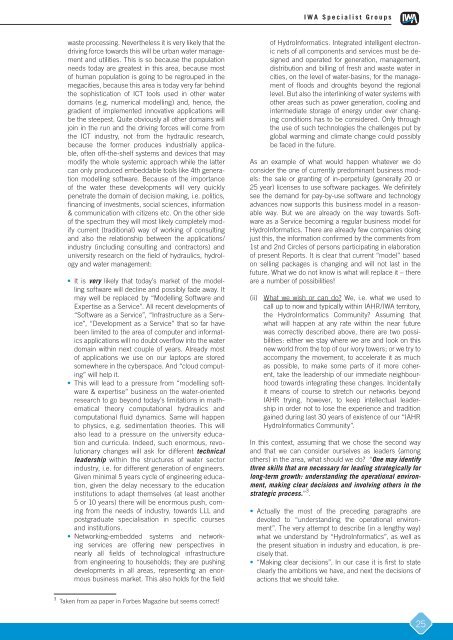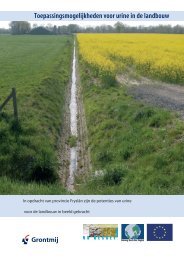IWA Specialist Group Directory - Nieuwe Sanitatie - Stowa
IWA Specialist Group Directory - Nieuwe Sanitatie - Stowa
IWA Specialist Group Directory - Nieuwe Sanitatie - Stowa
You also want an ePaper? Increase the reach of your titles
YUMPU automatically turns print PDFs into web optimized ePapers that Google loves.
waste processing. Nevertheless it is very likely that the<br />
driving force towards this will be urban water management<br />
and utilities. This is so because the population<br />
needs today are greatest in this area, because most<br />
of human population is going to be regrouped in the<br />
megacities, because this area is today very far behind<br />
the sophistication of ICT tools used in other water<br />
domains (e.g. numerical modelling) and, hence, the<br />
gradient of implemented innovative applications will<br />
be the steepest. Quite obviously all other domains will<br />
join in the run and the driving forces will come from<br />
the ICT industry, not from the hydraulic research,<br />
because the former produces industrially applicable,<br />
often off-the-shelf systems and devices that may<br />
modify the whole systemic approach while the latter<br />
can only produced embeddable tools like 4th generation<br />
modelling software. Because of the importance<br />
of the water these developments will very quickly<br />
penetrate the domain of decision making, i.e. politics,<br />
fi nancing of investments, social sciences, information<br />
& communication with citizens etc. On the other side<br />
of the spectrum they will most likely completely modify<br />
current (traditional) way of working of consulting<br />
and also the relationship between the applications/<br />
industry (including consulting and contractors) and<br />
university research on the fi eld of hydraulics, hydrology<br />
and water management:<br />
• It is very likely that today’s market of the modelling<br />
software will decline and possibly fade away. It<br />
may well be replaced by “Modelling Software and<br />
Expertise as a Service”. All recent developments of<br />
“Software as a Service”, “Infrastructure as a Service”,<br />
“Development as a Service” that so far have<br />
been limited to the area of computer and informatics<br />
applications will no doubt overfl ow into the water<br />
domain within next couple of years. Already most<br />
of applications we use on our laptops are stored<br />
somewhere in the cyberspace. And “cloud computing”<br />
will help it.<br />
• This will lead to a pressure from “modelling software<br />
& expertise” business on the water-oriented<br />
research to go beyond today’s limitations in mathematical<br />
theory computational hydraulics and<br />
computational fl uid dynamics. Same will happen<br />
to physics, e.g. sedimentation theories. This will<br />
also lead to a pressure on the university education<br />
and curricula. Indeed, such enormous, revolutionary<br />
changes will ask for different technical<br />
leadership within the structures of water sector<br />
industry, i.e. for different generation of engineers.<br />
Given minimal 5 years cycle of engineering education,<br />
given the delay necessary to the education<br />
institutions to adapt themselves (at least another<br />
5 or 10 years) there will be enormous push, coming<br />
from the needs of industry, towards LLL and<br />
postgraduate specialisation in specifi c courses<br />
and institutions.<br />
• Networking-embedded systems and networking<br />
services are offering new perspectives in<br />
nearly all fi elds of technological infrastructure<br />
from engineering to households; they are pushing<br />
developments in all areas, representing an enormous<br />
business market. This also holds for the fi eld<br />
3 Taken from aa paper in Forbes Magazine but seems correct!<br />
<strong>IWA</strong> <strong>Specialist</strong> <strong>Group</strong>s<br />
of HydroInformatics. Integrated intelligent electronic<br />
nets of all components and services must be designed<br />
and operated for generation, management,<br />
distribution and billing of fresh and waste water in<br />
cities, on the level of water-basins, for the management<br />
of fl oods and droughts beyond the regional<br />
level. But also the interlinking of water systems with<br />
other areas such as power generation, cooling and<br />
intermediate storage of energy under ever changing<br />
conditions has to be considered. Only through<br />
the use of such technologies the challenges put by<br />
global warming and climate change could possibly<br />
be faced in the future.<br />
As an example of what would happen whatever we do<br />
consider the one of currently predominant business models:<br />
the sale or granting of in-perpetuity (generally 20 or<br />
25 year) licenses to use software packages. We defi nitely<br />
see the demand for pay-by-use software and technology<br />
advances now supports this business model in a reasonable<br />
way. But we are already on the way towards Software<br />
as a Service becoming a regular business model for<br />
HydroInformatics. There are already few companies doing<br />
just this, the information confi rmed by the comments from<br />
1st and 2nd Circles of persons participating in elaboration<br />
of present Reports. It is clear that current “model” based<br />
on selling packages is changing and will not last in the<br />
future. What we do not know is what will replace it – there<br />
are a number of possibilities!<br />
(ii) What we wish or can do? We, i.e. what we used to<br />
call up to now and typically within IAHR/<strong>IWA</strong> territory,<br />
the HydroInformatics Community? Assuming that<br />
what will happen at any rate within the near future<br />
was correctly described above, there are two possibilities:<br />
either we stay where we are and look on this<br />
new world from the top of our ivory towers; or we try to<br />
accompany the movement, to accelerate it as much<br />
as possible, to make some parts of it more coherent,<br />
take the leadership of our immediate neighbourhood<br />
towards integrating these changes. Incidentally<br />
it means of course to stretch our networks beyond<br />
IAHR trying, however, to keep intellectual leadership<br />
in order not to lose the experience and tradition<br />
gained during last 30 years of existence of our “IAHR<br />
HydroInformatics Community”.<br />
In this context, assuming that we chose the second way<br />
and that we can consider ourselves as leaders (among<br />
others) in the area, what should we do? “One may identify<br />
three skills that are necessary for leading strategically for<br />
long-term growth: understanding the operational environment,<br />
making clear decisions and involving others in the<br />
strategic process.” 3 .<br />
• Actually the most of the preceding paragraphs are<br />
devoted to “understanding the operational environment”.<br />
The very attempt to describe (in a lengthy way)<br />
what we understand by “HydroInformatics”, as well as<br />
the present situation in industry and education, is precisely<br />
that.<br />
• “Making clear decisions”. In our case it is fi rst to state<br />
clearly the ambitions we have, and next the decisions of<br />
actions that we should take.<br />
25



